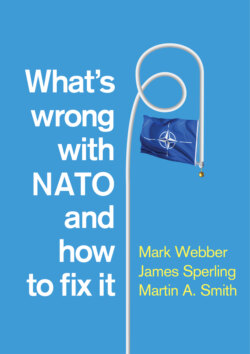Читать книгу What's Wrong with NATO and How to Fix it - Mark Webber - Страница 28
Hard Choices
ОглавлениеAn expanded agenda means there is simply more for NATO to do, and many of its tasks are exceptionally difficult to execute. NATO has assumed an almost heroic quality: it claims to have taken whatever action necessary to keep the allies and their one billion citizens safe, and accepted the necessary price of that effort in blood and treasure.57 But such a view is too forgiving. NATO is not simply a victim of circumstances. Some of the problems it faces have followed from the particular choices it has made.
Afghanistan provides a telling example. It was not inevitable that NATO would end up in an open-ended commitment to the country. The Taliban had been overthrown before NATO took charge of ISAF in 2003 and at that point Afghanistan was reasonably stable. However, within a short space of time, a regrouped Taliban had dragged NATO into a counter-insurgency war, which by 2006 was already described as ‘unwinnable’.58 Yet the NATO/ISAF mandate was extended time after time, and eight years would elapse before the Alliance ended its combat mission, with the Taliban no nearer to defeat. NATO, for sure, operated under exceptionally testing circumstances. Afghanistan is one the world’s poorest countries, and the government of Hamid Karzai which the Alliance partnered for many years was both manifestly inept and corrupt. The nation-building mission thus proved next to impossible to execute despite huge inflows of financial aid. As for the military dimension, the Taliban (aided by clandestine support from Pakistan) proved a tenacious opponent. NATO was reasonably adept at tactical innovation and made a valiant effort to train national Afghan armed forces. Despite well-reported political divisions among the allies, at its peak in 2011, some 130,000 personnel were under ISAF command – drawn from all NATO’s then twenty-eight nations alongside over twenty partner countries. This was no mean feat of political and military will. The positive impact on Afghanistan itself was less marked, however. Official statements portrayed ISAF in a positive light right up to the end of its mission in 2014.59 But such optimism was belied by the release in late 2019 of classified documents which revealed persistent doubts among American civilian and military officials at the wisdom of policies they themselves had been overseeing.60 By that point, the US had spent over $750 billion on the military effort in Afghanistan plus some $130 billion on civilian projects. It had also endured nearly 1,900 fatalities and over 20,000 casualties. The UK, for its part, had suffered over 450 deaths, a figure by 2010 already higher than in the Falklands War. The number of total war dead in Afghanistan, meanwhile, was estimated at 147,000, including 38,000 Afghan civilians.61 And yet the Taliban insurgency showed no sign of abating. The US government’s own reporting estimated that insurgent activity in 2019 was higher than at any time since 2001.62 This was the context within which NATO’s Resolute Support mission then operated. Post-ISAF, the Alliance had clearly retreated from the ambitious agenda of its first ten years in Afghanistan, but to what strategic end and over what time scale remained an open question. NATO had committed at the 2018 Brussels summit to fund assistance to the Afghan security forces until 2024, in pursuit of ‘long-term security and stability’. But a survey of Afghan specialists in February 2018 had already noted that alliance and American aims were ‘largely unachievable and Afghanistan’s future [is] only partly salvageable’.63 In 2009, the US had appointed Richard Holbrooke as its first Special Representative for Afghanistan and Pakistan. Holbrooke soon concluded that counter-insurgency in Afghanistan was failing. Efforts by the Obama administration to open talks with the Taliban, however, proved half-hearted.64 Trump took a more decisive approach, but the upshot was a deeply controversial agreement (pp. 89–90).
Russia provides another example of the consequences of hard choices. Here, tensions have been an all-too-predictable downside of enlargement. The arguments mobilized in favour of the policy may have been powerful and the benefits to new members tangible and real. But Russia objected to the policy from the outset. Critics in NATO countries echoed these concerns: George Kennan, the architect of America’s Cold War strategy of containment, warned in 1997 that enlargement could prove ‘the most fateful error of American policy in the entire post-Cold War era’.65 For some, he was proved right. As we show in Chapter 4, efforts at NATO–Russia partnership failed to blunt Moscow’s opposition, and once the Alliance chose to support Georgian and Ukrainian membership, things spiralled downward. Both the Russo-Georgian war of 2008 and Russia’s annexation of Crimea in 2014 can be seen as pre-emptive moves by Moscow to forestall Georgia and Ukraine from joining NATO. Russia, particularly in Crimea, is in clear violation of international law, but whatever the legal position, as John Mearsheimer has pointed out, ‘anyone with a rudimentary understanding of geopolitics should have seen this [crisis] coming. The West was moving into Russia’s backyard and threatening its core strategic interests.’66 Russia’s ‘backyard’ also includes the three Baltic States – Estonia, Latvia and Lithuania – all of which were once incorporated into the Soviet Union. Russian officials in the 1990s indicated that there, too, NATO membership for these countries was ‘categorically unacceptable’.67 NATO went ahead regardless. Moscow did not respond with active intervention, but the armed build-up in Russia’s Western military district since places the Baltics in a position of huge vulnerability. Most studies conclude that NATO would be unable to defend them in the event of a Russian attack.68
